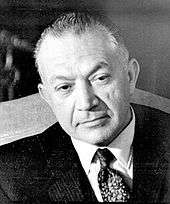Roberto M. Levingston
| Roberto M. Levingston | |
|---|---|
 | |
| 36th President of Argentina De facto | |
|
In office June 18, 1970 – March 21, 1971 | |
| Preceded by | Juan Carlos Onganía |
| Succeeded by | Alejandro Lanusse |
| Personal details | |
| Born |
January 19, 1920 San Luis, Argentina |
| Died |
June 17, 2015 (aged 95) Buenos Aires, Argentina |
| Nationality | Argentine |
| Political party | None |
| Spouse(s) | Betty Nelly Andrés |
| Children |
Roberto Antonio María Cristina Alberto Marcelo |
| Profession | Military |
| Religion | Roman Catholicism |
Roberto Marcelo Levingston Laborda (January 19, 1920 – June 17, 2015) was an Argentine Army general who was President of Argentina from June 18, 1970 to March 22, 1971, during the Revolución Argentina period in Argentine history.[1][2]
Levingston was born in San Luis Province, and graduated from the Colegio Militar de la Nación in 1941.[3]
His military expertise included intelligence and counterinsurgency, and he took the presidency of Argentina in a military coup that deposed Juan Carlos Onganía over his ineffective response to the Montoneros and other guerillas.[2] His regime was marked by a protectionist economic policy that did little to overcome the inflation and recession that the country was undergoing at the time,[1] and by the imposition of the death penalty against terrorists and kidnappers.[2] In response to renewed anti-government rioting in Córdoba and to the labor crisis under his leadership, he was deposed by another military junta led by Alejandro Lanusse.[1][2]
He died on June 17, 2015, at the age of 95.[3]

References
- 1 2 3 Lewis, Daniel K. (2001), The History of Argentina, The Greenwood histories of the modern nations, Greenwood Publishing Group, pp. 134–135, ISBN 978-0-313-31256-4.
- 1 2 3 4 Keen, Benjamin; Haynes, Keith (2008), A History of Latin America (8th ed.), Cengage Learning, p. 374, ISBN 978-0-618-78318-2.
- 1 2 "Murió Roberto Marcelo Levingston", La Nación (in Spanish), June 18, 2015